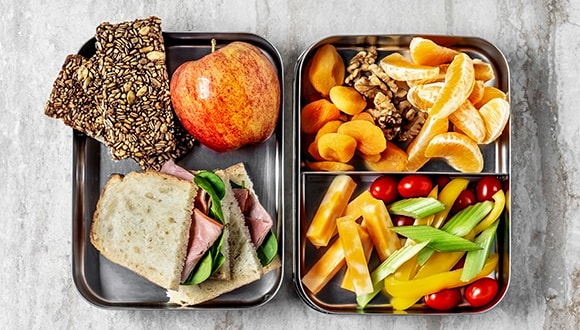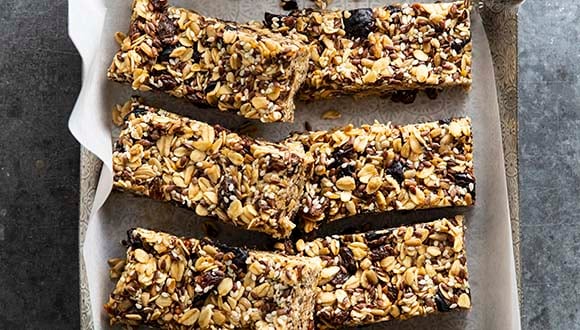15 healthy lunchbox snacks to nourish your kids
Updated February 2024 | 5 min read
Expert contributor Dr Jane Watson, paediatric dietician, Ethos Health
Words by Donnay Torr
Building healthy eating habits in youngsters can be a tricky business. Here’s how to 'dangle a carrot', using some expert tips and healthy snack ideas for kids.
It's safe to say most children would not put vegies like broccoli at the top of their 'favourite food' list. But the good news for parents trying their best to encourage healthy eating is this: going back to basics works.
Food provides the fuel our kids need to play, grow and learn – and healthy snacks don't need to be complicated to meet their needs. Find out how to plan a healthy lunchbox, with easy snack ideas that kids will love.
The importance of healthy eating for kids
Young, growing bodies need a range of nutrients, vitamins and minerals to flourish, so the more diverse their lunchbox snacks, the better. Making sure your kids are eating a variety of foods is important not only for their physical health but also for their concentration, energy and mood throughout the day. "Adults can feel irritable and 'hangry' if we don't have enough to eat throughout the day, and children are no different," says Dr Jane Watson, an accredited practising dietitian specialising in paediatrics at Ethos Health. "Even very young children’s behaviour can change noticeably when they’re 'running on empty'."
Dr Watson suggests following the tried-and-tested Australian guidelines for healthy eating and including food from each of the five food groups to provide nutrients like:
- protein: builds muscle and repairs tissue
- calcium: strengthens bones and teeth
- iron: helps red blood cells deliver oxygen to the entire body
- fibre: keeps the digestive system happy
- vitamins: each vitamin has a role to play in your child’s health, from boosting their immune system to supporting vision, memory retention and skin health.
If your child is a fussy eater, keep an eye on their iron intake, says Dr Watson. "Children need a lot of iron because of their rapid growth, but iron-rich foods [like chewy steak] can be challenging for some children to eat. Low iron levels can also reduce appetite, which can make fussy eating worse."
If you're concerned, Dr Watson recommends speaking to an accredited practising dietitian who specialises in child or adolescent nutrition. They can check your child’s iron levels and offer advice on how to make sure they’re getting enough iron in food.
Encouraging healthy habits
Spending hours curating the perfect healthy lunchbox snacks only to discover your efforts have been left uneaten is extremely frustrating. But here’s the thing: you don’t need to be a Pinterest-perfect parent to keep your child healthy.
"Spending lots of time and energy on preparing food for our kids can mean we’re more invested in our child eating them, which can put unnecessary pressure on both parents and children," says Dr Watson.
Rather than insisting your child eats more or less food, she suggests the focus should be on eating together at mealtimes and enjoying food. Allowing your child to respond to their own cues of feeling hungry or full also helps them develop healthy eating patterns, she says. "Kids will usually end up eating healthy foods if they’re provided in a positive, supportive, no-pressure way."
It’s also important to remember that children mirror their parents’ behaviour and habits. "The eating habits of the adults in the house have an enormous influence on what children eat," says Dr Watson. "Sharing mealtimes and showing children that we’re enjoying the foods we want them to eat makes it more likely that they’ll eat them in the future."

What to do if your child won’t eat
Some children eat very little or even nothing at school, says Dr Watson. "They may be busy playing or finding more interesting things to do than eat, or perhaps the school environment is challenging, which impacts their appetite." Speak to your child and the school staff to better understand what may be going on. "However, if your child is growing well and thriving at school, pack less in their lunchbox and offer a filling breakfast and afternoon snack instead."
If your child keeps refusing healthy snacks or tends to eat only certain foods, consider their overall food intake. One possible culprit could be the ease and availability of highly processed foods. "Packaged foods are often tasty, easy to eat and don’t change from one packet to the next, so kids get very used to their predictability," explains Dr Watson. "They can make kids less inclined to eat fresh foods, which vary widely in taste, appearance and texture."
Children who 'graze' throughout the day may also be fussier. If they’re never hungry enough, they’re unlikely to eat foods outside their 'comfort zone', says Dr Watson. 'For example, if your child is filling up on milk or snacks, they may not be hungry enough to eat a meal. Having a break between meals and snacks gives them a 'time to eat' and a 'time to get hungry', which can help increase the foods they regularly eat."
Planning a healthy lunchbox: keep it simple
The golden rule of healthy lunchbox snacks for kids? Keep it simple. "If your child eats all five food groups, great. Pack something from each group," says Dr Watson. "If you enjoy making special lunches, go ahead. But if packing lunchboxes is taking its toll, pack what you think your child will eat: it doesn’t matter if that means a Vegemite sandwich every day. Reduce the stress on everyone and provide other options outside school."
If your child's school offers the Crunch&Sip (or Fruit Break) nutrition program, make sure they take a vegetable and/or fruit snack and water, says Dr Watson – even if they’re not too keen on eating it. "Chat to them about what they might want to take, and keep your expectations low – or zero. Only pack small amounts to reduce overwhelm and food waste. Continuing to include something communicates to children that we believe that one day they will eat it!"

Try adding these easy homemade muesli bars to your child's lunchbox.
15 healthy lunchbox ideas for kids
- Stock up on fruit: any kind, including fresh, dried and canned.
- Pop some popcorn: pre-popped packets or pop fresh at home – it’s cheap and quick. Most children can help or make popcorn themselves once they’ve been shown how.
- Pile crackers with cheese, vegemite or hummus.
- Boil some corn on the cob: corn is rich in fibre and vitamins.
- Make a banana hotdog: spread peanut butter on flatbread and wrap around fruit.
- Fill a small pita pocket with ‘confetti’: Vegemite, grated cheese, celery and colourful vegies like carrot and capsicum.
- Get creative with egg muffin cups.
- Team broccoli florets, sugar snap peas, raw beans, sliced carrots or celery with a healthy dip or salad dressing.
- Bake flatbread until crisp and serve with a healthy dip like hummus.
- Core an apple, slice into rings, then spread with peanut butter and crushed wholegrain cereal.
- Make icy poles by freezing fruit juice.
- Try these healthy chocolate quinoa squares.
- Whip up some easy cheese pots by halving a tomato, scooping out the insides and fill with light cream cheese and corn kernels.
- Fill up after school with an afternoon serve of wholegrain cereal or easy homemade muesli bars.
- Keep good alternatives to soft drinks on hand, like diluted fruit and vegie juices, low-fat milk and chilled water.
A helping hand with kids’ nutrition
We've partnered with Ethos Health to bring our members Healthy Families for Life and Healthy Teens for Life, which are resources to support kids, from birth to teens, to develop positive nutritional habits for growth and development and reduce the risk of chronic conditions in their future. Eligibility criteria applies*.
Related articles
Guide to nutrition for kids
Nutrition is vital at every stage of kids' development and parents play a key role in encouraging healthy eating habits from a young age. Here’s how.
Back-to-school health checks
Along with new books and uniforms, there are several health checks that are important for kids to get a good start to the year. Put these on your back-to-school checklist.
Tips to talk peer pressure
Peer pressure is a normal part of growing up. Here’s how to spot the signs your kid might be experiencing peer pressure and how to help them navigate through it.
Healthy eating for kids
If your child is a fussy eater, it can be difficult to make sure they’re getting the nutrition they need. Here’s how to deal with picky eaters – from toddlers to teenagers.
IMPORTANT INFORMATION
* Service is available to all HCF members with any HCF health insurance product (excluding Overseas Visitors Health Cover), see hcf.com.au/healthyfamilies
This communication contains information which is copyright to The Hospitals Contribution Fund of Australia Limited (HCF). It should not be copied, disclosed or distributed without the authority of HCF. Except as required by law, HCF does not represent, warrant and/or guarantee that this communication is free from errors, virus, interception or interference. All reasonable efforts have been taken to ensure the accuracy of material contained on this website. It’s not intended that this website be comprehensive or render advice. HCF members should rely on authoritative advice they seek from qualified practitioners in the health and medical fields as the information provided on this website is general information only and may not be suitable to individual circumstances or health needs. Please check with your health professional before making any dietary, medical or other health decisions as a result of reading this website.